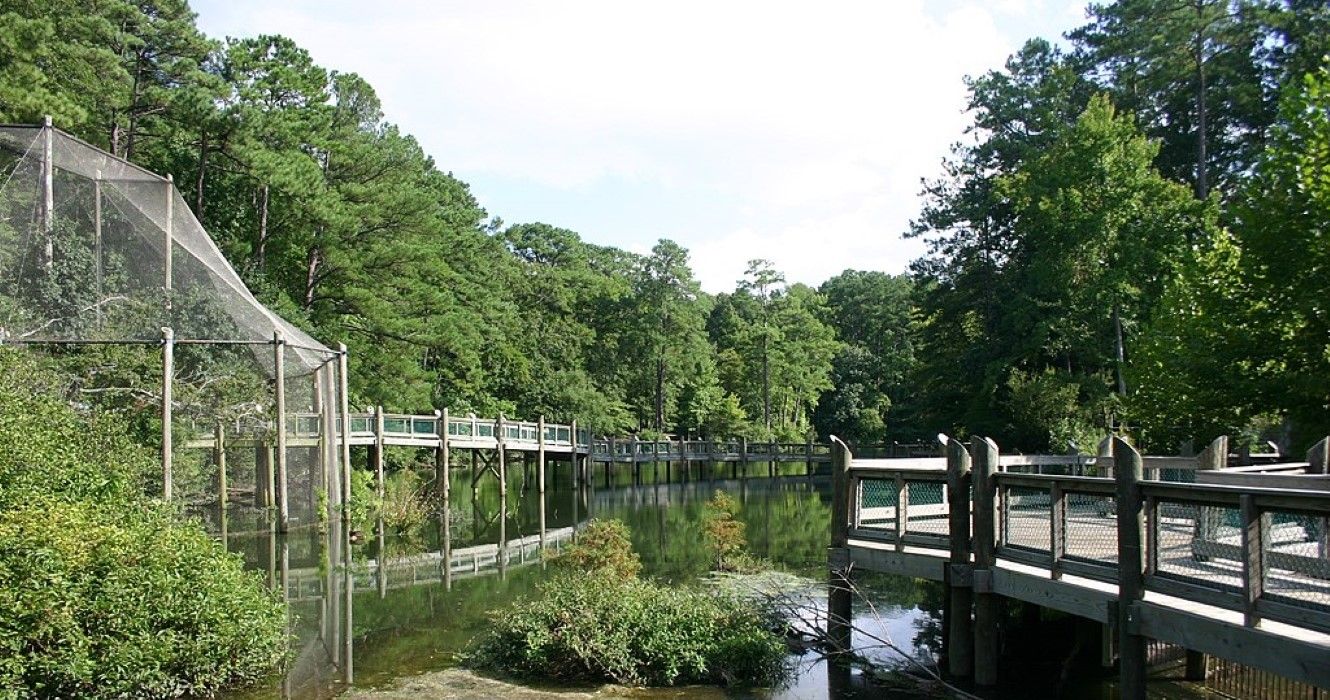Quick Links
Some 250 living species, including animals, reptiles, plants, marine life, birds, and amphibians, all native to Virginia, thrive in the Virginia Living Museum. Located in Newport News, just north of Virginia Beach and bordered by the Chesapeake and Burwell bays, the museum offers exhibits, hands-on activities, and discovery centers, and even introduces visitors to outer space with its planetarium and observatory, making a visit an exciting adventure for children and adults alike.
The facility, at 524 J. Clyde Morris Blvd., has functioned as a museum since 1966. It's been expanded over the years and was named the Virginia Living Museum in 1987 as a combination wildlife park, science museum, aquarium, botanical preserve, and planetarium. The past and future come together at the museum, with fossilized dinosaur tracks in one exhibit and a futuristic “green” building known as the Goodson House in another.
The Goodson House is made of recycled materials, has a roof covered with living plants, derives energy from solar panels, and has geothermal pumps for heating and cooling. In a bid to inspire others, the museum has installed a computer kiosk where visitors calculate their carbon footprint.
Walk Through And Explore Natural Habitats
Museum visitors can immerse themselves in various natural environments as they make their way through glass-covered habitats. In Appalachian Cove, a waterfall, mountain stream, and lake showcase various fish and birds. In Cypress Swamp, visitors will see all kinds of swamp creatures, including an alligator and snapping turtle.
The Coastal Plain Gallery delves deep into the Chesapeake Bay habitat, where exhibits include the 30,000-gallon Noland Chesapeake Bay Aquarium, where large sea creatures live, and an underwater view of marine life one might find on wooden pilings beneath the ocean.
The Piedmont and Mountains Gallery takes its inspiration from the James River in Richmond, and is loaded with smallmouth bass, catfish, yellow perch, and wood and spotted turtles.
Suspended from the ceiling over the museum's main staircase is a six-foot-diameter globe meant to show the earth as viewed from space. Underneath, visitors will see a scientifically authentic replica of a dinosaur that may have lived in Virginia 200 million years ago.
Dinosaurs are a big focus of the Virginia Living Museum. Several years ago, it opened the Dinosaur Discovery Trail, which is an outdoor exhibit highlighting 16 dinosaurs that roamed the earth for more than 150 million years. Visitors can walk along the wooded trail to see dinosaurs from the Jurassic and Cretaceous eras, some of them at full size. Youngsters will surely delight in seeing a 16-foot-tall Brachiosaurus plus a half-size T. rex. The trail features a children’s play area, dig pits for amateur paleontologists, and displays of dinosaur fossils.
Fossils of other animals are found in the Virginia Underground Gallery, which shows a cut-away of the fossil layers found along the James River.
Children Can Role Play As Animal Keepers
The Virginia Living Museum has several learning opportunities designed just for children, such as the Wild and Well program. In this section of the museum, kids can pretend they're animal keepers, and help staff prepare food for the animals. There's a play kitchen with food bins, animal diet cards, and animal holding cages with stuffed animals. Youngsters also can imagine they are veterinarians, using play props such as x-ray walls and stethoscopes.
Other activities for kids include the Chesapeake Bay Touch Tank and the Children's Garden. Geared for preschoolers, the garden's Nature Playground features a Hobbit House along with plants that attract pollinators, plus many birds and butterfly caterpillars.
Look Up, In The Planetarium And Observatory
The museum's Abbitt Planetarium is a 70-seat theater with a digital simulation that can project the sky as seen from anywhere on earth, according to the museum. The projection system allows internet access, enabling the planetarium to show real-time images of events in space, including streaming NASA TV. Various shows are held, and these vary by season. Open Friday to Sunday, the planetarium charges a $6 entry fee, plus museum admission. Star Party/Laser Nights are held on the second Saturday night of every month and cost $8 to attend.
Meanwhile, for those keen to learn more about outer space, visitors to the Abbitt Observatory can see daytime views of the sun plus nighttime views of the stars, planets, and galaxies. Stargazing is held on the second Saturday evening of every month and is free. The use of the observatory and its 16-inch Meade telescope is weather dependent.
Museum Entry Is By Timed Admissions
The Virginia Living Museum offers timed admission, but once guests enter the facility, they can stay as long as they wish. Non-ticketed visitors are accommodated as space is available in the timed admission slots. The museum is open daily from 9 a.m. to 5 p.m.
- Admission costs: Adults 13 and up, $23.95; children 3 to 12, $16.95; children two and younger, free.
- Tours: Behind the Scenes tours: Aquarium, $20; Garden, $20; VIP Living Exhibits, $30.

